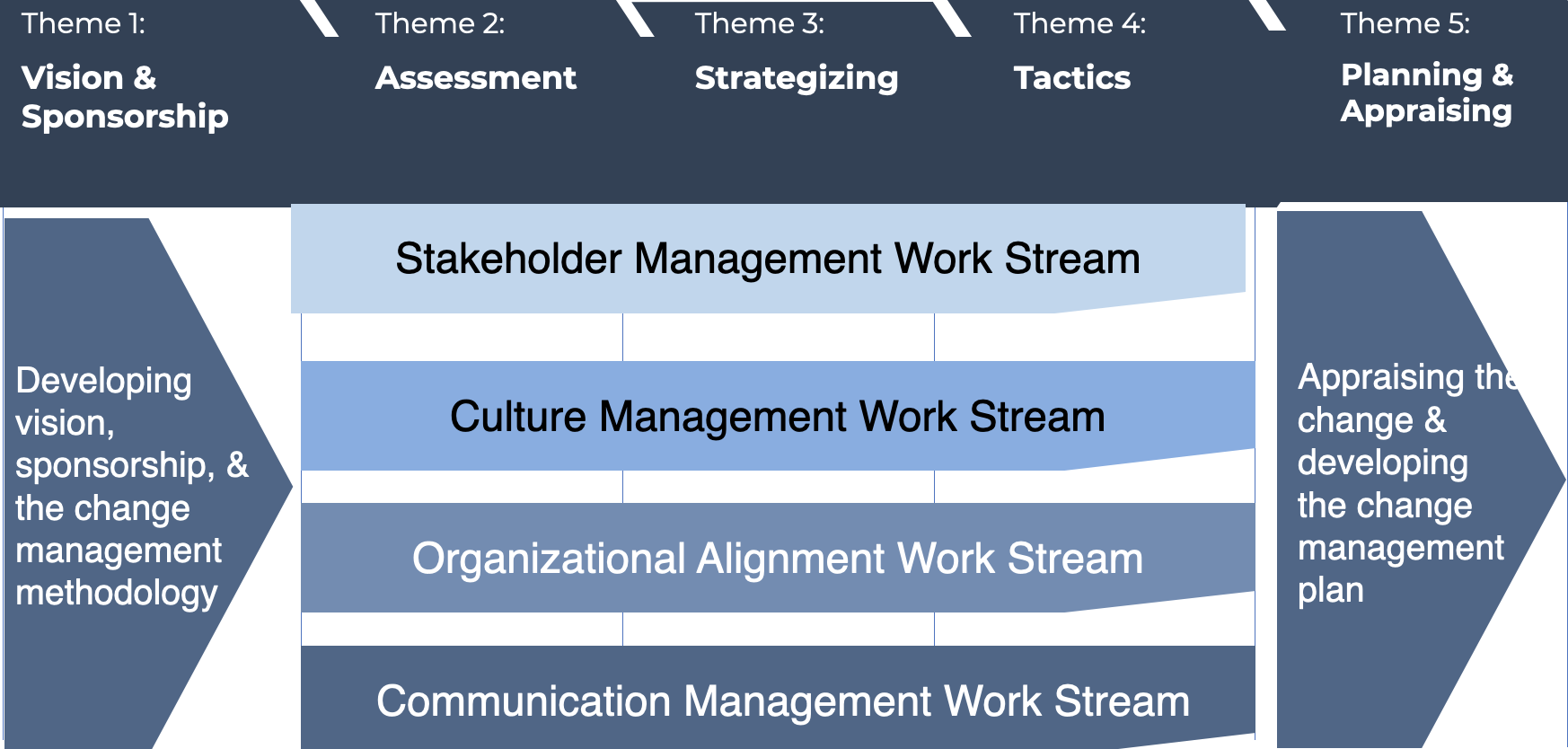From 2012 to 2016
Qualitative research was conducted on the 5-Theme Model under the supervision and mentorship of Swiss Management Center University, with support from ITIM International, trading as Hofstede Insights in Finland and the Netherlands.
After completing the interviews and quantitative and qualitative surveys of two case studies, we collected, coded, and categorized the data into themes and sub-themes. we then designed the five themes of the model along with its components.
After the model’s research and development was concluded, it was introduced in a doctoral dissertation in 2016. In 2017, the 5-Theme Model was published in a paper in the Arabian Journal of Business and Management Review under the title: The Five Themes of Change Management.
After nearly three years of writing, editing, and review, the most recent version of the model is published in the book: BRIDGING THE GAP Between Strategy Development and Strategy Execution.
ElKattan’s 5-Theme Model for Change Management was designed to provide practical tools to manage both the organizational and individual aspects of any change. In addition to these two aspects, the model manages the culture using both Hofstede and the Multi-Focus Models.
ElKattan’s 5-Theme Model for Change Management was designed to provide practical tools to manage both the organizational and individual aspects of any change. In addition to these two aspects, the model manages the culture using both Hofstede and the Multi-Focus Models.
Why our ElKattan’s Model is unique?
- A research-based change management model
- Fills the gap in literature between strategy development and strategy execution
- Practical Links between change management and other areas
- A Culture based model that highlights the influence of culture on change
One of our interesting models is ElKattan’s ACE Model, which is made up of four layers; each layer consists of a number of elements, which impact the stakeholders’ participation in any change initiative. These layers are as follows:
Layer 1: Assumptions and Beliefs
This layer is the deepest one, which is not easy to reach. It has two main elements that greatly affect the participation and engagement toward the change: Assumptions and Beliefs toward the change.
Layer 2: Awareness, Competence, and Engagement
This layer has three elements that represent the methodology of the model: Awareness (A), Competence (C), and Engagement (E).
Layer 3: Rationale and Emotions
This layer has two elements that have the highest impact on the stakeholders’ behaviors toward the change initiative: Rationale and Emotions.
Layer 4: Intention to Behave and Behaviors
This layer has two elements related to behaviors: Intention to behave toward the change and actual behaviors. Figure 9-8 shows the layers and elements of ElKattan’s ACE Model
The Four Change Management
Work Streams

A core concept of ElKattan’s Model for Change Management is its change management work streams, making the model comprehensive, unique, and balanced.
Each work stream directs a critical perspective related to the change. The model’s work streams are: (1) Stakeholder management, (2) Culture management, (3) Organizational alignment, (4) Communication management. They are characterized in this way in order to make the model balanced by addressing within each stream the different areas that may impact the change implementation.
The three components in each row in the shown figure represent the tactics identification stage in each work stream. The three components are from the three themes: assessment, strategizing, and tactics. For example, the culture work stream has its own dedicated components: One component to assess the culture, one to develop the culture management strategy, and the last one to identify the culture management tactics.
The components of each work stream should be linked together and executed consecutively.
Stakeholders Management
This work stream ensures that the stakeholders are aware, engaged, and competent throughout the implementation of the change
Culture Management
This work stream ensures that the culture is assessed and managed throughout to motivate the implementation and increase willingness to change.
Organizational Alignment
This work stream ensures the right organizational enablers are in place to deliver the project outputs, as well as the sustainers to ensure the sustainability of the change.
Communication Management
This work stream ensures that the both stakeholders’ “head” and “heart” are addressed to increase the awareness, engagement, and willingness to change and support to achieve the change goals.

